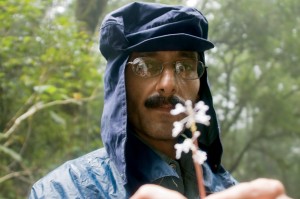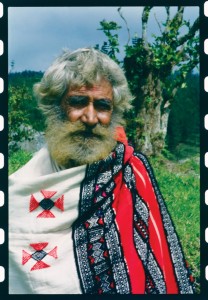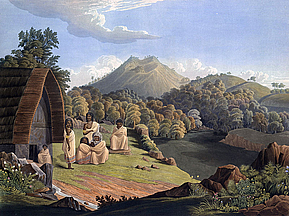
Forbes Magazine
 |
Dr. Tarun Chhabra © M. C. Tobias |
Environmentalism is, by definition, given to skepticism, dismay, political cynicism and the seemingly endless endeavors to guide human nature along a path more sustainable than that currently on display worldwide.
Yet, in India, the second most populated nation on earth, with her inordinate share of ecological turmoil and over 1.241 billion people, there exists an ancient, indigenous community of vegetarians, the Todas, whose lifestyle and footprint suggests a true window on what humanity - at its best - is capable of.
I’m referring to a community, in 2013, that is ethically vegetarian, non-violent; that may well be the most sustainably-committed community in human history. The Sistine Chapel of pure living; a “Maria Vespers” of the moral and geographical compass. A group of denizens who, if you are tracking ecological success stories, are front-page news.
Moreover, at the core of some of this community’s habitat remains the last remaining “wilderness” in all of India; unexplored by most. This region - the inner Nilgiris - hosts the last best hope for India’s wild tigers and one of three remaining wild populations of Asian elephants. Moreover, it is a botanical collective of astonishing dimensions in which - depending on the precise season, and day (or night) - are a vast number of endemic species known particularly well by one man - Dr. Tarun Chhabra.
Thanks to this remarkable ecologist, a practicing dentist by profession, and brilliant ethnobotanist, Dr. Tarun Chhabra, I have had the privilege over the course of many years, of spending time with this community: the Todas, on numerous occasions. In 1992, Dr. Chhabra and colleagues set about to preserve the Toda heritage, which was facing increasing pressure - demographic, toxicological, economic, genetic, cultural, legal - all those bedeviling challenges that can exponentially accumulate in the name of modernity and India’s increasingly palpable habitat fragmentation. Indeed, the Toda heartland was the same Western Upper Nilgiris aggregate of ecosystems that were also being threatened. Urgent measures were needed to save what was left of this habitat that is unique in all of Asia. Dr. Chhabra and colleagues established a non-profit Trust “EBR” which stands for the Edhkwehlynawd Botanical Refuge to help rally support for the Toda who dwell within the core biological area of India’s first recognized biodiversity hotspot and UNESCO biological World Heritage Site.
What endows this community with such a unique place in the bio-cultural context of southern India, and - for that matter- the whole world - is not merely the fact that they are one of the only vegetarian tribal groups left on Earth (while surrounded by meat-eating communities); or the computable realization that their ecological footprint, by even today’s economically-much marginalized rural Indian standards, is statistically zero.
 |
Toda Gentleman © Dr. Tarun Chhabra |
What is utterly amazing about the Todas is their true biological sustainability. They magnificently integrate their own culture and rich biodiversity; a markedly restrained humanity, shy ethos, distinctly pan-Asian reclusiveness, and poetic landscape revery inherent in the tools of personal and community existence. This defines ecosystem person-hood. In the case of the Todas, it would appear to derive, at least in part, from their explicitly animist cultural rituals, traditions, beliefs, and worldview. This Renaissance-ecological orientation is a powerful argument in favor of the possibilities of the human species, after all. For thousands of years the Todas have worshipped a rare species of (now endangered) Asian river buffalo and have practiced non-violence with rare, consistent vigilance. Even their so-called “noyim,” a form of conflict-resolution, is so subtle that to be present at such a gathering (as I have been) you would never know a problem was even being resolved. Toda crises are not fought out at the last second, like fiscal-cliffs in Washington, although the stakes - if you are a Toda - are no less critical.
It must be professed that the Todas argue for one of the most advanced lessons on Earth in reference to how human beings can harmoniously engage in what Voltaire summarized in his novel, Candide (1759) when he suggested, in the end, that we simply cultivate our gardens. Remarkably, the Todas are not even that inflictive upon nature. Trans-montane ritually nomadic pastoralists, they restrain from nearly all traditional agricultural exploitation (not unlike the majority of India’s Jain communities - except that the Toda hamlets are to be found in rural, even wilderness areas, not in the urban environments, where most Jain communities are located.)
In 1873, a British ethnographer, W. E. Marshall, visited the Todas and wrote of them that they were, in essence, a total ethnographic anomaly, or anachronism; that they engaged in no hunting, no meat eating; no violent sports, no violence whatsoever. Marshall wondered, therefore, whether he had not come upon “the tracks of an aboriginal reign of conscience?” and asked, “Was man originally created virtuous as well as very simple?” His famed riposte to his own culturally-condemned conjectural inanity was that “in this absence of vigorous qualities; in the disregard of gain and thrift; as well as in their [the Todas'] ultra domesticity, we have the attributes of a primeval race.”
That “primeval race” - that ultimate “reign of conscience” remains true to form in southern India; a bio-cultural Eden about which the human 21st century needs urgently to take notice.
I asked my friend, Dr. Chhabra – who lives just a few miles away from one of several Toda hamlets, about this wonderful and unique community of Todas today; their beliefs (herewith simplified, to be sure); and the threats to their livelihood. Toda environmentalism offers a rare window on human possibilities and optimism. Its anodynes and rudiments have tested the arc of time, whilst at least 22 other known human civilizations have risen, and fallen, as chronicled by such historians as the late Arnold Toynbee and Clarence Glacken.
Michael Tobias: Dr. Chhabra, what makes the Todas so globally unique, certainly from a ecological point of view?
Tarun Chhabra: I would attribute it to a combination of the following factors: The Todas live at the heart of the Nilgiri Biosphere Reserve - in the highlands where they have traditionally been strictly pastoral people, with no history of farming. Much of their entire worldview revolves around an endemic breed of buffalo. They rely on the buffalo for the mainstay of their economic livelihood, derived from dairy products - sacred milk and butter
Michael Tobias: Of course, then, they are not vegan, but, as I have witnessed, they treat those buffalo like dignitaries, royalty.
Tarun Chhabra: That, and the fact the Todas are generally vegetarian folk with apparently no history of hunting. Moreover, their traditional architecture has been celebrated. The Head of Architecture at MIT is bringing out a book on “First Societies and their Architecture” where he is including the Toda structures.
Moreover, their language has been reported to have the most complex phonetic system in India. Most importantly, the Todas have managed to adopt a manner of sustainable living and have kept their own population low over the centuries.
Michael Tobias: Zero population growth in India is certainly uncharacteristic, notwithstanding an inspired array of family planning luminaries and legislation throughout the nation. But India’s Democracy, as you well know, has not managed, ultimately, to come to grips with a demographic speeding train, most saliently in those EAG (Empowered Action Group) states where the TFR, or Total Fertility Rates are still as high as 3.9, such as is the case within the States of Bihar, or Rajasthan. To come upon a community of replacement fertility trends, and one with sovereign, historic staying power, is miraculous.
Tarun Chhabra: Even today, the orthodox Toda community number just over 1400 persons.
Toda Priest, Youngsters and Sacred Buffaloes © Dr. Tarun Chhabra
 Dr. Michael Tobias
Dr. Michael Tobias

